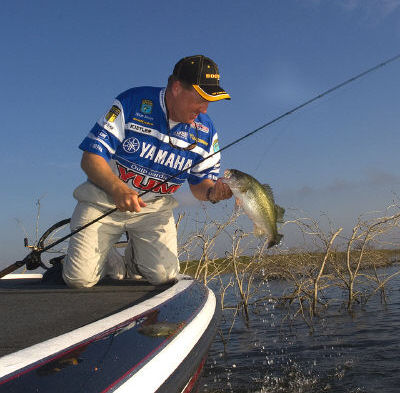Classic Champ Likes Jigs For Autumn Bass
"I'll have two jigs, a spinnerbait,
and a shallow running crankbait tied on and ready," notes the Yamaha pro, who's
already spent time scouting Louisiana's Red River where he'll defend his Classic
title next February, "but jigs are definitely my favorite lures this time of year.

|
|
It's autumn, and that means Bassmaster Classic champion Alton Jones will be fishing jigs. |
"A lot of bass will be feeding on crayfish, and jigs imitate crayfish very effectively.
During the fall months bass are moving shallow so jigs are fun and easy lures to
use, too.”
Jones looks for fall bass in tributary creeks, generally from mid-way in to the
back of the creek; seldom does he look at water deeper than 12 feet and many of
his bass may be as shallow as 12 inches.
“The most important ingredient is that the creek have a well-defined channel,” he
continues, “and while I will certainly pitch or flip my jigs to visible bushes and
stumps, I generally catch more fish around rocks because they have more crayfish.
“The vertical edge of the channel is important because water temperature is gradually
getting cooler as autumn progresses and bass like to move vertically with those
temperature changes. For example, if I’m fishing on a colder day I’ll definitely
concentrate on the steeper side of the channel or the outside of a bend, but if
I’m fishing on a bright, warmer day, I’ll fish the shallower side of the channel
or the inside of that same bend.”
The two jigs the Yamaha pro has tied on are normally a small profile 3/16-oz. finesse
jig and a slightly larger ¼-oz. normal jig. He wants to use the lightest jig possible
for the conditions, although he doesn’t fish in true “finesse” fashion; even with
a 3/16-oz. model, Jones often uses braided line.
Although green-pumpkin and black/blue are among his favorite jig colors in autumn,
Jones generally includes some crayfish red or orange in his jig trailer just to
make it look more attractive. He doesn’t worry about matching the jig color with
the trailer as much this time of year as he does during the spring and summer months.
“I want the jig to fall as vertically as possible, so I pitch or flip rather than
make casts,” he explains, “and once the jig reaches the bottom, I don’t hop it and
jump it. I’ll crawl it a short distance, especially if there is other cover around,
or I’ll raise my rod and then lower it again to allow the jig to fall again, but
then I’ll reel it back.
“I’ll try to cover a channel bank thoroughly, pitching every three feet or so as
I move along. You seldom find schooling bass in the backs of creeks this time of
year, but you often find areas or specific stretches of a bank that are more productive
than others, but to locate them you still have to cover the water.”
Although jigs are favorite lures this time of the year, the Yamaha angler
cautions that most bass fishermen use jigs that are too heavy. The key to successful
jig fishing is getting a slow fall because the bass themselves are less aggressive
in the cooling water. “With a lighter jig that falls slower, you’re also forced
to fish slower,” he concludes, “but that’s the way you’ll catch bass this time of
year.”
Reprinted with permission from Yamaha Engines.